Are you looking to enhance your website’s search engine rankings with minimal effort?
Our latest article explores 20 SEO quick wins that can quickly boost your site’s visibility and traffic.
These strategies range from optimizing meta tags to improving mobile usability and can usually offer immediate results with little effort. Focusing on these so-called low-hanging fruits can help your SEO campaign gain momentum and lay a solid foundation for more complex, long-term strategies.
Read on to discover how simple actions like fixing broken links, adding alt text to images, and leveraging user-generated content can significantly improve your website’s performance.
What is an SEO Quick Win?
An SEO quick win is a term used to describe an action or strategy that can be implemented easily and potentially quickly to improve your search engine rankings. These are often low-hanging fruits, requiring minimal effort (compared to other tasks) but offering a high return on investment (ROI).
Some examples of SEO quick wins include:
- Optimizing title tags and meta descriptions
- Improving page load speed
- Fixing broken links
- Updating old content with fresh information and keywords
Quick wins are often used to gain momentum within an SEO campaign by providing quick results that can enhance a website’s visibility and traffic. They also help to build a solid foundation for more complex, longer-term SEO strategies. This is often because they address basic issues holding a site from ranking higher in the SERPs.
20 SEO quick wins for your website
We’ve compiled a list of SEO quick wins that should improve your organic traffic and SEO performance. We’ll cover everything from optimizing meta tags to adding alt text to images, optimizing your website’s URLs, leveraging featured snippets, and more.
However, it’s important to note that these are just suggestions, and any changes you make to any of your pages should be measured to see the impact, which is where SEOTesting can help you. With SEOTesting, you can change your site and track the resulting SEO impacts of that change over a designated time period. Take this example of a content refresh on our website:
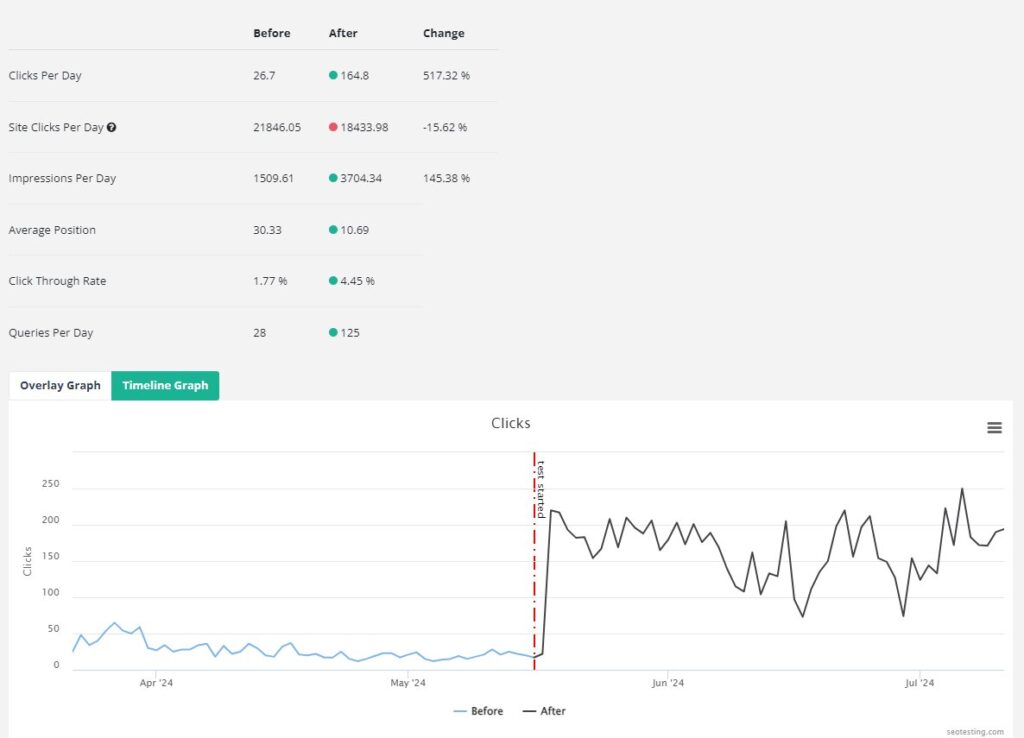
You can find more information on SEOTesting at the end of the article.
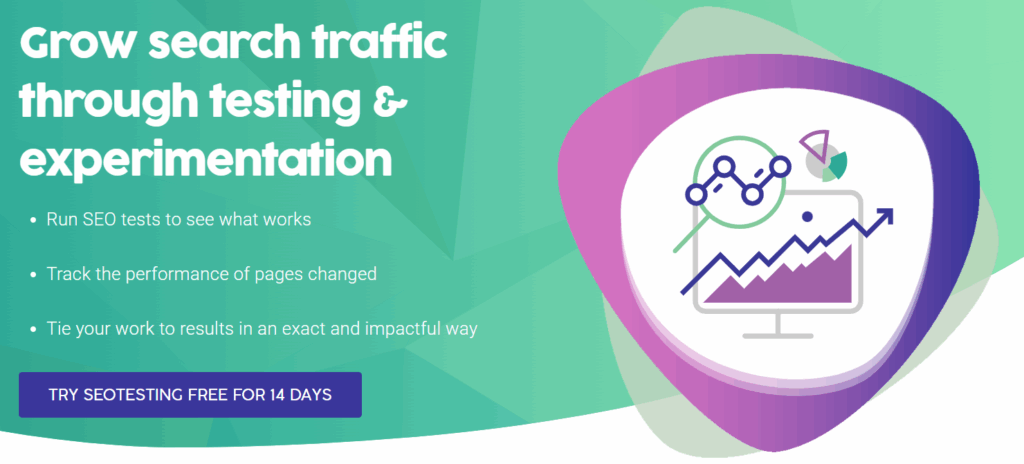
Quick Win 1: Optimizing meta tags
Optimizing your meta tags perfectly fits the mold of an SEO quick win. It requires minimal effort but can significantly impact your website’s visibility and click-through rates.
Meta tags, particularly your meta titles and meta descriptions, play a crucial role in how search engines understand and display web pages in search results. More importantly, they let users know what they can learn about your site by looking at its SERP snippet.
By ensuring your meta tags are relevant, include relevant search queries, and are compelling, you can quickly enhance your listing in the SERPs to both users and search engines.
The screenshot below shows the change in clicks to a page, where all we did was update the meta title and meta description (and ran it through our checker) to include the top-ranked query for that page:
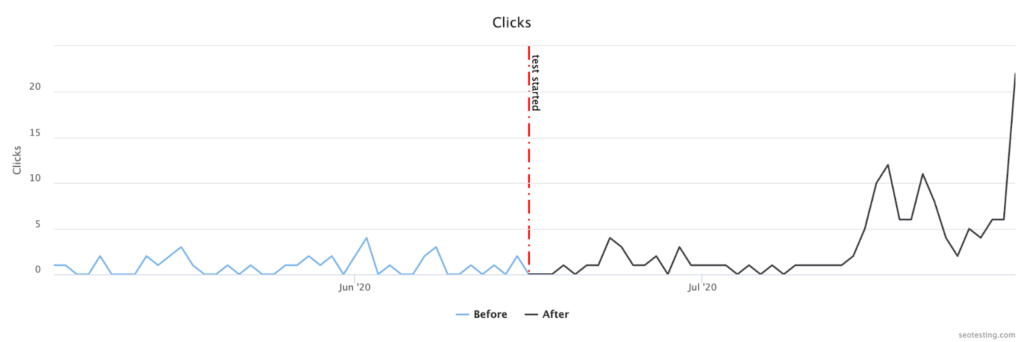
An action item for optimizing meta tags
You can use the Top Query Per Page report in SEOTesting to identify any meta titles and descriptions on your website that are missing queries that are driving high numbers of clicks and/or impressions:

For example, we can see that our website’s page on SEO browser extensions is missing the query “SEO Chrome extension” within the meta description, which is the top query this page is ranking for. Adding this query to our meta description is a quick win for us to test.
Quick Win 2: Improving page load speed
Another great quick win for SEO is improving your site’s load speed, which can lead to better rankings and an improved user experience.
We already know that search engines like Google favor faster-loading pages, prioritizing providing users with the best possible experience. A quicker load time reduces the likelihood of a user bouncing back to the SERPs because they are less likely to click off of frustration about the page load time.
Page speed optimization can be carried out through different measures that should be relatively straightforward, including:
- Compressing images
- Leveraging browser caching
- Minimizing HTTP requests
These actions are often easy to implement and, thanks to the improved user experience, have the potential to bring immediate results.
An action item for improving page load speed
Before running a crawl of your website on Screaming Frog’s SEO Spider, you can connect to the Google PageSpeed Insights API to find the page speed metrics for each of your website’s URLs:
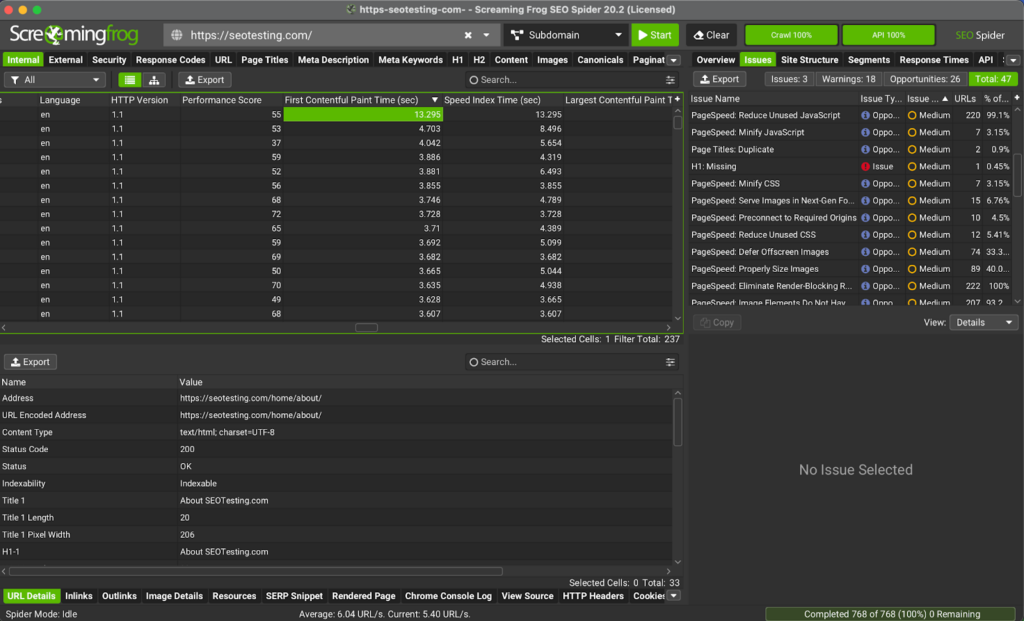
Using this data, you can see which of your pages have low scores and prioritize these for fixes.
Depending on the issue causing the low page speed, you may be able to fix it yourself or send it to your website’s development team. However, prioritizing these pages will help improve page speed.
Quick Win 3: Fixing broken links
For several reasons, fixing broken links is perhaps one of this list’s quickest and most effective wins.
Firstly, fixing broken links helps to give your users a good experience on your website. For example, suppose they are scrolling through an article they have come to on the SERPs and see an internal link to an article that does not work. In that case, this can leave them feeling annoyed and may encourage them to click off and bounce back to Google—compared to the ideal experience of a user clicking on a site in the SERPs, reading through, clicking on an internal link, and then closing the browser – which is the experience you want!
Secondly, ensuring your site has no broken links on its pages will help Googlebot and other search engine crawlers crawl your website more effectively. This can allow your content to be indexed quicker, especially if it’s internally linked, and will also lead to a better distribution of link equity across your pages.
An action item for fixing broken links
A crawling tool like Screaming Frog or Sitebulb can uncover anything you need to fix. The example below shows how to check for broken links within Screaming Frog, but the process is also repeatable across other crawling tools.
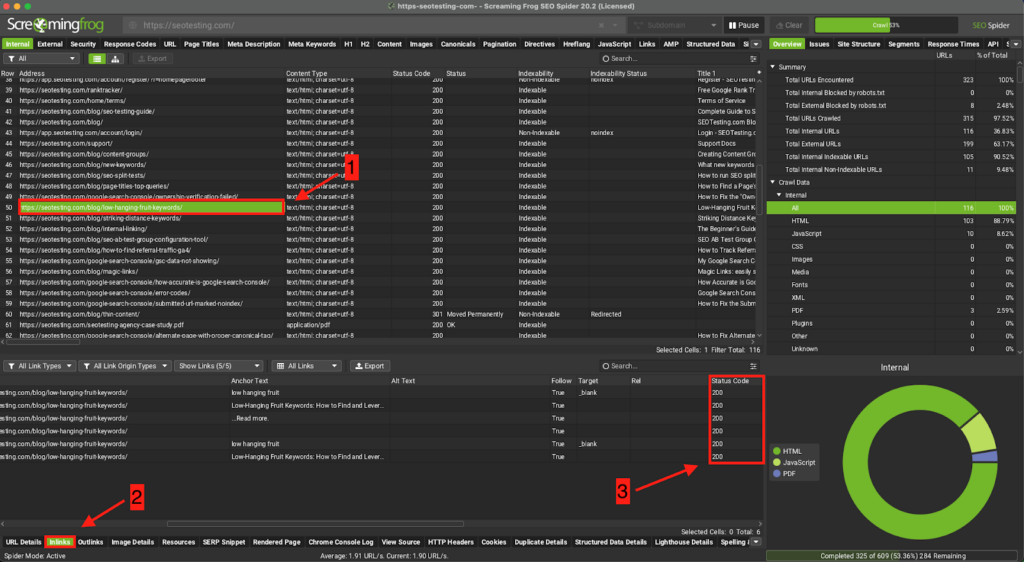
Run a crawl of your site, click on the link you want to examine in the list of your crawled URLs, click the inlinks tab, and ensure that all the inlinks return an HTTP 200 status code. Do the same for your outlinks tab to ensure the page doesn’t link to broken links.
Quick Win 4: Adding alt text to images
Adding alt tags to the images on your site is great for SEO – not only does it enhance accessibility, but it can also improve search engine visibility. Alt tags provide a text-based description of images, making your content accessible to visually impaired users who need screen readers. This broadens your audience and demonstrates a commitment to inclusivity, which can positively impact your website’s reputation.
From a purely SEO perspective, alt tags help search engines understand the content of your images. This can help with better indexing, which may then lead to higher rankings, especially in image search results. By including relevant keywords in your alt tags, you can increase the chances of your images appearing in search queries – driving additional traffic to your site.
This type of optimization requires minimal effort, especially if you use a Content Management System (CMS) such as WordPress, which allows you to add alt tags directly within the tool.
An action item for adding alt text to your website’s images
A quick way to add alt text to images is using a plugin or bulk editor within your content management system (CMS). For example, if you’re using WordPress, you can install plugins like SEO Optimized Images or Auto Image Alt Text. These tools automatically add alt text based on the image file name or other criteria.
Some CMS platforms, like Shopify or Wix, have built-in bulk editing features. These allow users to easily access the media library, select multiple images, and add alt text in batches, saving time and ensuring consistency.
It’s best to manually add relevant and descriptive alt text directly within the CMS for high-priority or frequently used images. This method offers a quick solution across many images, improving accessibility and SEO without needing individual attention.
Quick Win 5: Improving internal linking
Internal linking can benefit your site in the following ways:
- Better navigation through the site
- Improves user engagement
- Helps search engines understand site structure
- Reduces the risk of orphan pages being present on your website
Improving internal linking is a great SEO quick win because it can help users find related content easily. This keeps them on the site longer and reduces bounce rate. By guiding visitors to relevant pages, you increase the likelihood of engagement and conversions.
Internal linking is also great for search engines and helps your site’s on-page SEO.
A well-structured internal linking system makes it much easier for search engines to crawl and index your website. It lets crawler bots understand the build of your site and the relationship between different pages, which can help to improve your rankings.
Additionally, internal links distribute link equity throughout your site, giving important pages more authority and visibility. But this works for smaller (or newer) pages, too. By linking out to these types of pages from your high-ranking and high-authority pages, you can quickly help these smaller or newer pages build authority.
An action item for improving internal linking
You can use InternalLinking to quickly find opportunities to add internal links to your existing content. Simply enter the URL of the page you want to build internal links to, and InternalLinking will find internal link opportunities by searching either:
- Your website’s top 1000 pages as determined by Google Search Console
- Performing a site search query on Google (site:yoursite.com query)
- Getting the pages that Google Search Console returns for your chosen queries
It will then present you with a list of internal link opportunities that you can run through and add to your site:
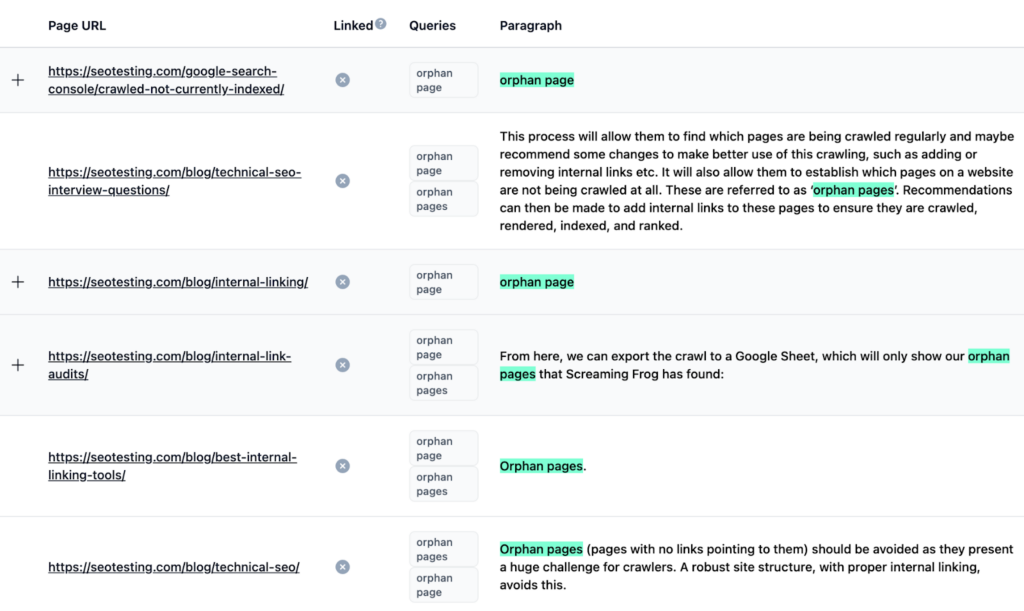
Quick Win 6: Updating content
Another SEO quick win is updating your web content, which keeps the information on your pages current, relevant, and competitive. Search engines favor fresh and accurate content, so regularly updating your pages can lead to higher rankings and increased traffic as you stay ahead of your SERP competitors. Revising outdated information, adding new insights, and incorporating up-and-coming keywords ensures your content is valuable to your audience.
At SEOTesting, we perform regular content refreshes to maintain the relevance of our pages and stay competitive for our target queries. Here’s an example of the results of a content refresh we completed in the past:
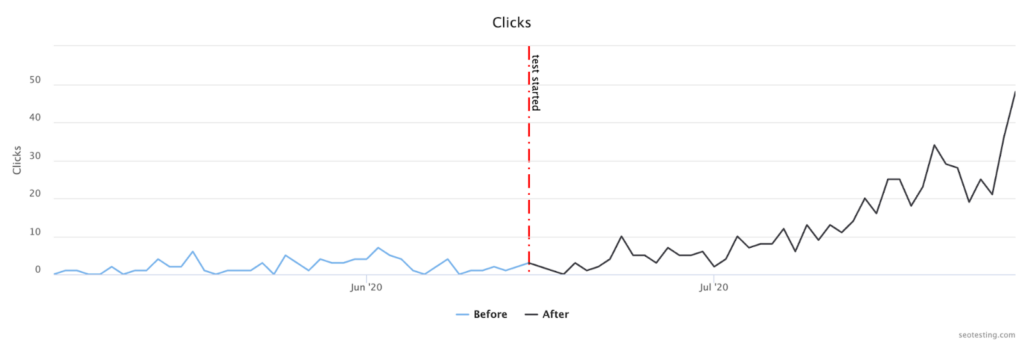
The boost in clicks to that page happened almost immediately, with a big spike towards the test’s end.
But it wasn’t just the page’s clicks that went up. We also saw an increase in the page’s impressions:
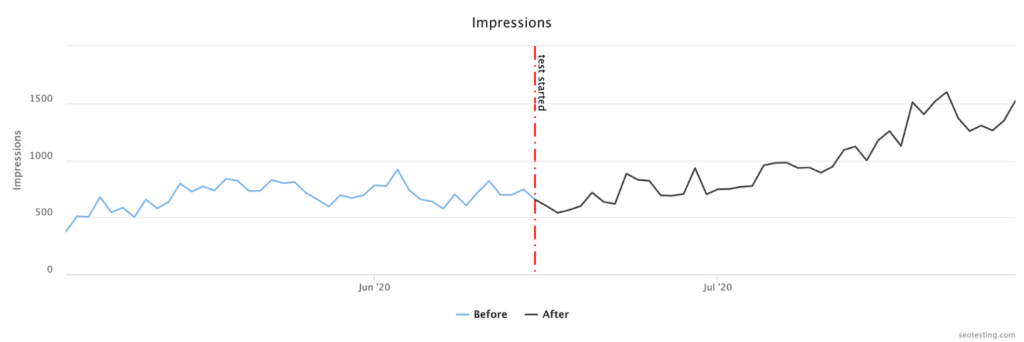
As well as the page’s average position in the SERPs:
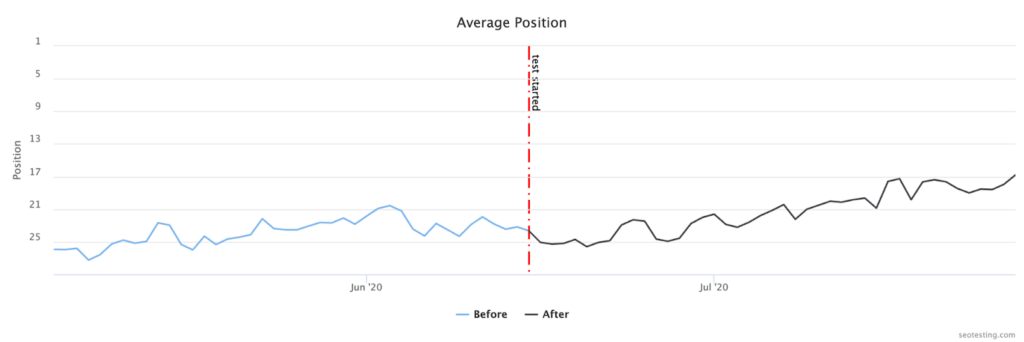
And the page’s CTR:
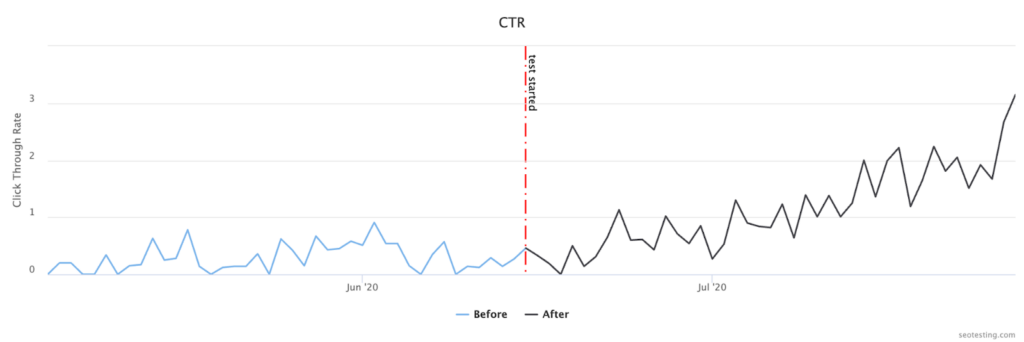
Action item for updating content on your website
Look at the Content Decay report within SEOTesting to identify content that has lost clicks without spending hours exporting data from Google Search Console.
The Content Decay report will report on all clicks (per month) for your content over the past thirteen months, report on the peak month, and then tell you how many clicks your content has lost since the peak month:
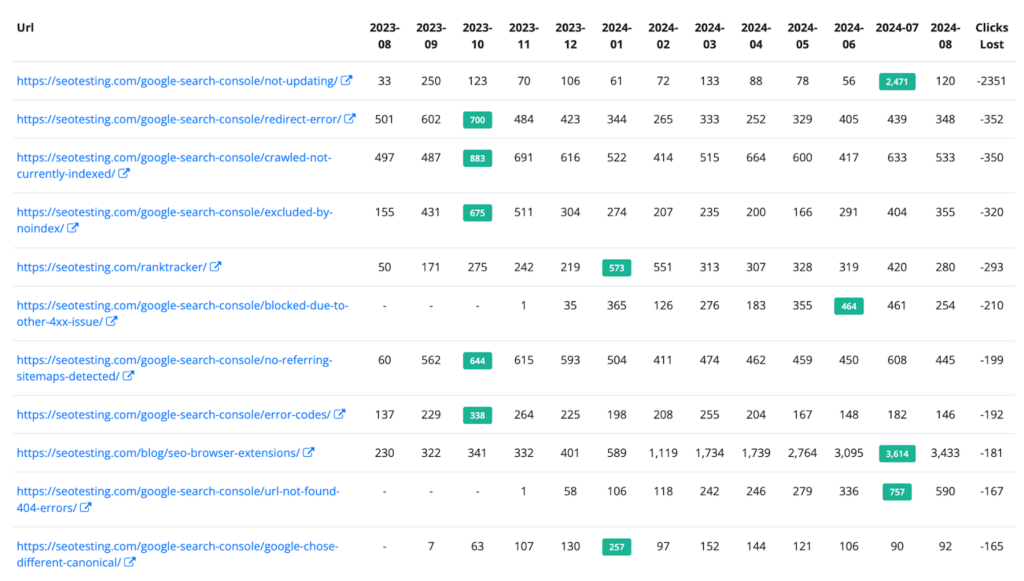
You can use this information to prioritize updates and get your content back on track.

Quick Win 7: Improving mobile usability
Improving a page’s mobile usability is a fantastic quick win that directly impacts user experience and search engine rankings.
With the majority of web traffic now coming from mobile devices, ensuring your site is mobile-friendly is crucial. An optimized page loads faster, is easier to navigate and provides a better overall user experience, which can reduce bounce rates and increase engagement.
We know that Google prioritizes mobile-friendly websites and has stopped indexing sites that are not accessible on a mobile device since July 5, 2024. If your business relies on web traffic, you must ensure your site is accessible from a mobile device to get it indexed and ranked in the SERPs.
Action item for improving mobile usability
If you are using Google Chrome, you can use the ‘inspect element’ feature within the browser to see how your website and web pages look from different mobile perspectives:
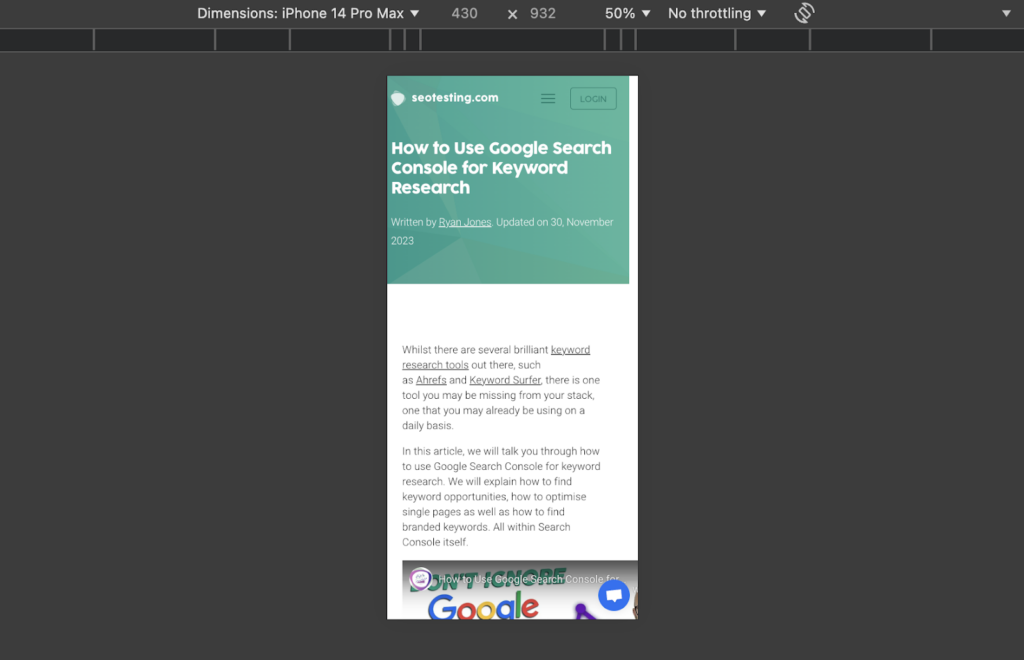
This will allow you to browse your site from a mobile user’s perspective and spot issues of mobile usability. For example, the screenshot above shows an embedded video on one of our blog posts that is causing a slight problem with the screen.
Quick Win 8: Optimizing URLs
Whenever you find a quick win that benefits user experience and search engine readability, you should make sure it is included in your next steps. With this in mind, optimizing your page URLs should be next on your agenda.
Clean, descriptive URLs that include relevant keywords can help users and search engines understand the page’s content at a glance. This clarity can lead to higher click-through rates from search results, as users are more likely to click on a link that clearly matches their search intent.
Optimized URLs can enhance a site’s crawlability and indexability. Search engines use URLs to determine a page’s context and relevance. You can improve your chances of higher SERP rankings by ensuring your URLs are short, well-structured, and include target queries.
An action item for optimizing URLs on your website
Your first step in optimizing URLs on your site should be to conduct a full review of all the page URLs. You can use a web crawling tool to do this. Find URLs that are long, unclear, or missing relevant keywords, update the URLs to be short, descriptive, and include your chosen keywords that align with search intent.
Ensure that any URLs you change have a proper 301 redirect implemented to maintain the SEO value and prevent broken links.
Quick Win 8: Adding schema markup
Adding schema markup is a great SEO quick win because it improves the way search engines understand and display your content within the SERPs, with the potential to improve visibility and click-through rates.
Schema markup is a form of structured data that gives search engines additional context about your site’s content, allowing them to create rich snippets that stand out in search results. These enhanced listings can include elements like:
- Star ratings
- Images
- Product information
- NAP (Name, Address, Phone Number) data
All of these rich snippets will help make your page more attractive to users in the SERPs compared with other pages that do not have any of these rich snippets available.
Here’s an example of a SERP which features rich snippets:
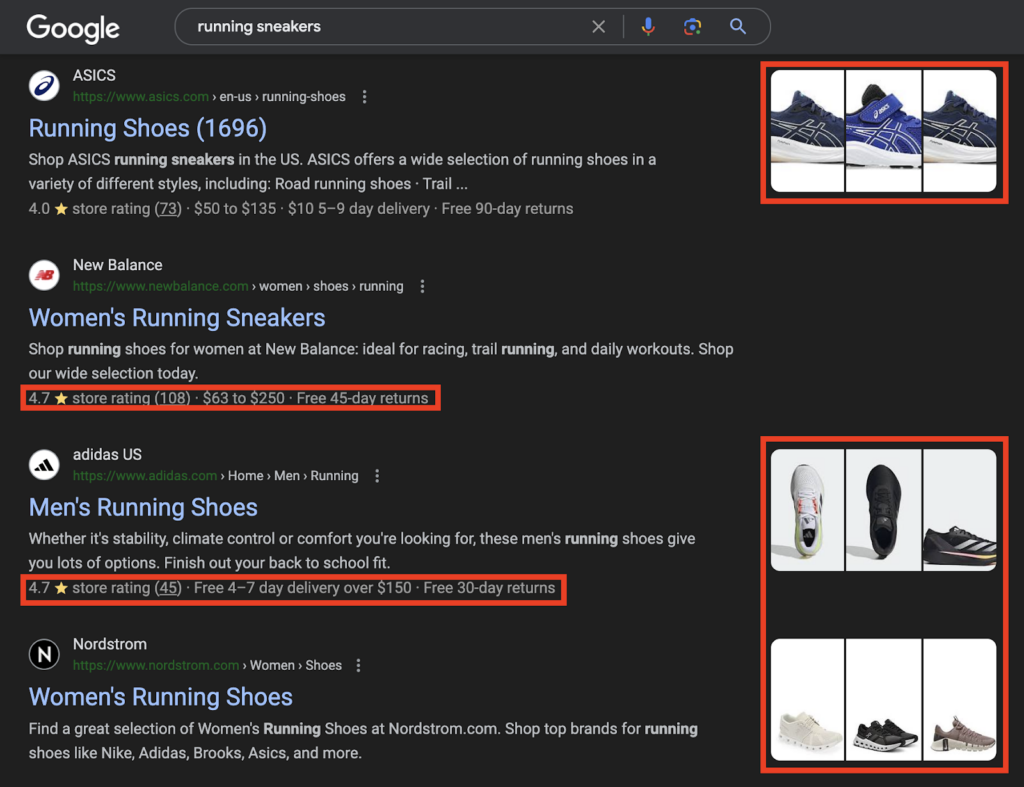
Implementing schema markup is relatively easy and can be done without extensive changes to your website’s content or structure. Adding this markup makes it simpler for search engines to accurately index your content, leading to better rankings. In addition, rich snippets created by schema markup can increase your page’s appeal, driving more organic traffic to your site.
An action item for adding schema markup to your pages
You can utilize ChatGPT to give you the schema markup you need for your pages. Take a look at this screenshot:
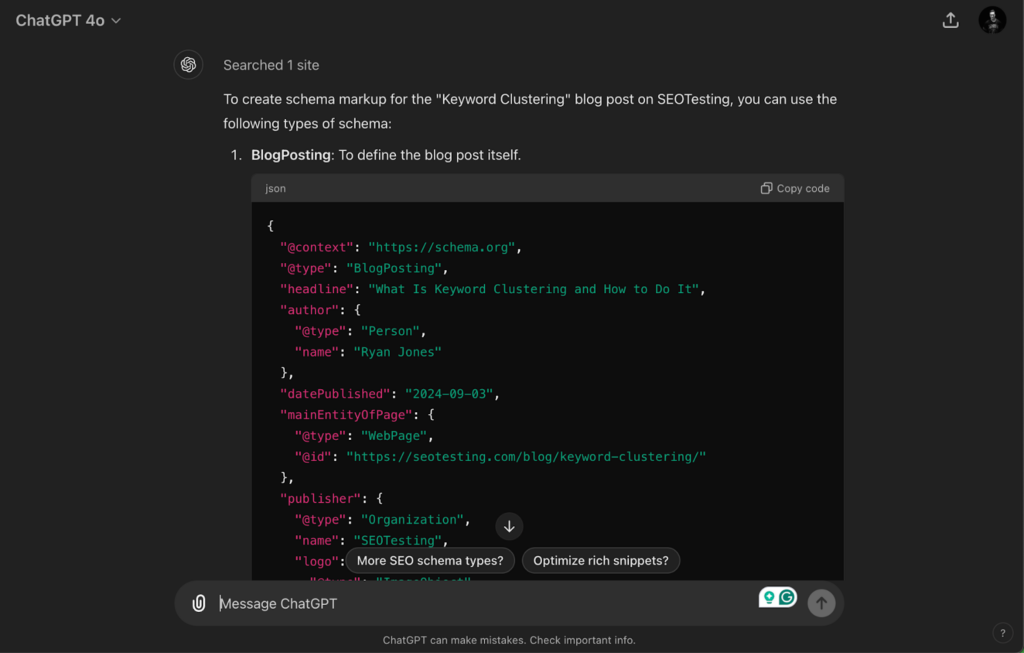
To get this, I simply gave it the URL for one of SEOTesting’s pages and asked it to give me all the schema markup I would need. It then provided me with:
- BlogPosting schema
- BreadcrumbList schema
- Article schema
All of which can be implemented to help Google better understand this page.
Quick Win 10: Enhancing a page’s user experience
Enhancing a page’s user experience is another excellent quick win for SEO professionals and marketers in general because it can have an immediate and positive impact on user engagement and search engine rankings. A positive user experience keeps visitors on your site longer, reduces bounce rate, and increases the likelihood of conversions. Easy navigation, fast load times, and an intuitive website design make users more likely to explore your site and engage with your content and/or products.
Search engines consider user experience signals such as:
- Page load speed
- Mobile-friendliness
- Ease of navigation
Enhancing your site’s user experience (UX) can align it with these ranking factors, potentially boosting its position in the search results. Many UX improvements, such as optimizing page speed, improving mobile usability, and simplifying site navigation, can be implemented relatively quickly, making them a no-brainer.
A well-designed user experience also guides visitors toward desired actions, whether purchasing, filling out a form, or signing up for your newsletter. You can boost conversion rates by removing obstacles and creating a smooth journey. UX enhancements often require fewer resources than more extensive SEO or marketing campaigns. They can be executed quicker, making it a cost-effective strategy with a high return on investment.
An action item for improving your website’s user experience
You can use a tool like Hotjar to provide heat maps of your site based on real user interactions.
These heatmaps (and recorded user sessions) can be used to determine which areas of your site are most engaging and where sessions can end unexpectedly, allowing you to improve.
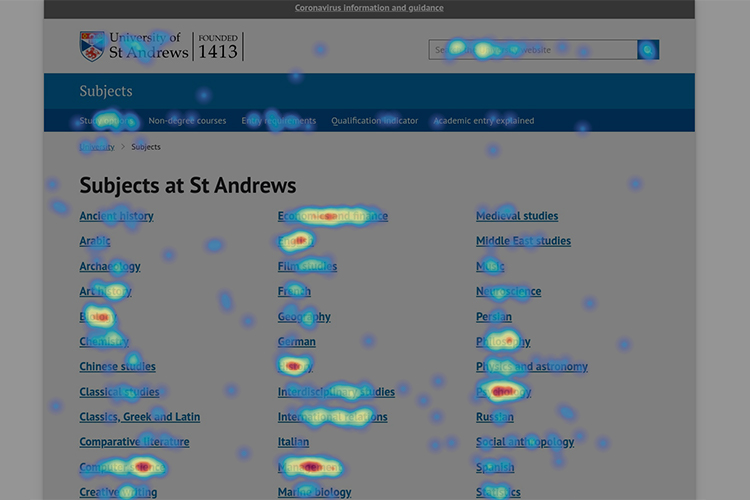
Quick Win 11: Leveraging user-generated content
Leveraging user-generated content (UGC) provides fresh, relevant content that can enhance your website’s visibility and engagement with little effort. Instead, you’re making the most of the content others have created, such as reviews, comments (in some situations), and social media posts to valuable, diverse perspectives to your site. This content type helps keep your site dynamic and up-to-date, which search engines favor when determining rankings.
UGC also fosters community and trust. Visitors seeing genuine interactions and feedback from other users builds credibility and encourages further engagement. This increased activity can lead to higher dwell times and lower bounce rates, which are positive signals for search engine algorithms.
In addition, user-generated content often naturally includes long-tail keywords and phrases that potential customers use in their search queries. This can help your site rank for broader search terms, attracting more organic traffic. Encouraging users to create content, such as reviews or forum posts, is a cost-effective way to keep enhancing your SEO efforts, making it a powerful and efficient strategy for boosting your site’s performance.
Here’s an example of some user-generated content on our website:
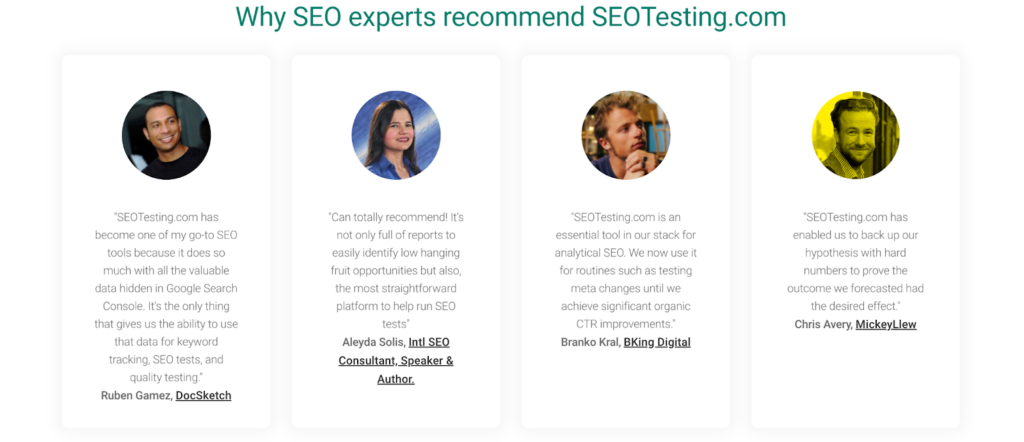
These reviews help to build a good level of trust with our potential customers.
An action item for leveraging user-generated content across your site
Social media is perhaps the best place to find and utilize user-generated content across your site. Take this example from Land of Rugs:

Screenshot from Land of Rugs
They are an online retailer selling rugs. As you can imagine, it’s hard to visualize what something looks like when buying online, so Land of Rugs provides examples from real customer photos on social media to help you better understand what a rug would look like in your home.
Quick Win 12: Using high-quality, relevant images
High-quality images make your content more visually appealing and encourage visitors to stay longer and interact more with your site. This is also likely to increase time spent on the page, lower the bounce rate, and help improve rankings.
Relevant images also help provide context to your content, making it easier for users to understand and retain information. When images are used appropriately and optimized with descriptive filenames, alt text (as we mentioned earlier), and captions, they provide additional context for search engines and improve the overall SEO of your page. Optimized images can also appear in image search results, which can drive extra traffic to your site.
Below, I have included a screenshot of our Google Search Console dashboard, which shows our website performance over the last 16 months:
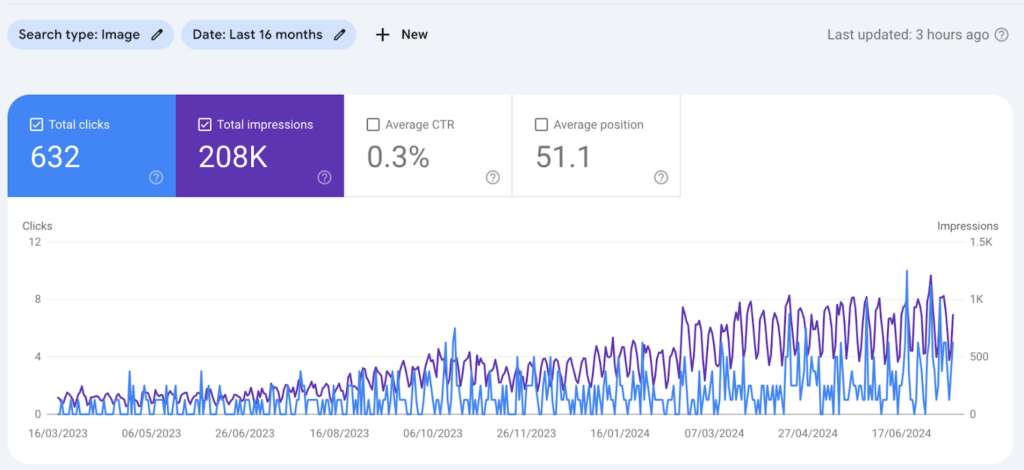
The kicker? This has been filtered to show only our traffic coming from image searches, which has led to an additional 632 clicks coming to our site over the last 16 months from images alone.
An action item for utilizing imagery on your website
Are you struggling to find images to use across your site? You can use ChatGPT (DALL.E) to generate images for you.
Let’s say, for example, that you run a pet blog and need to find an image of a cat. You can always ask ChatGPT to create one for you in your chosen style:
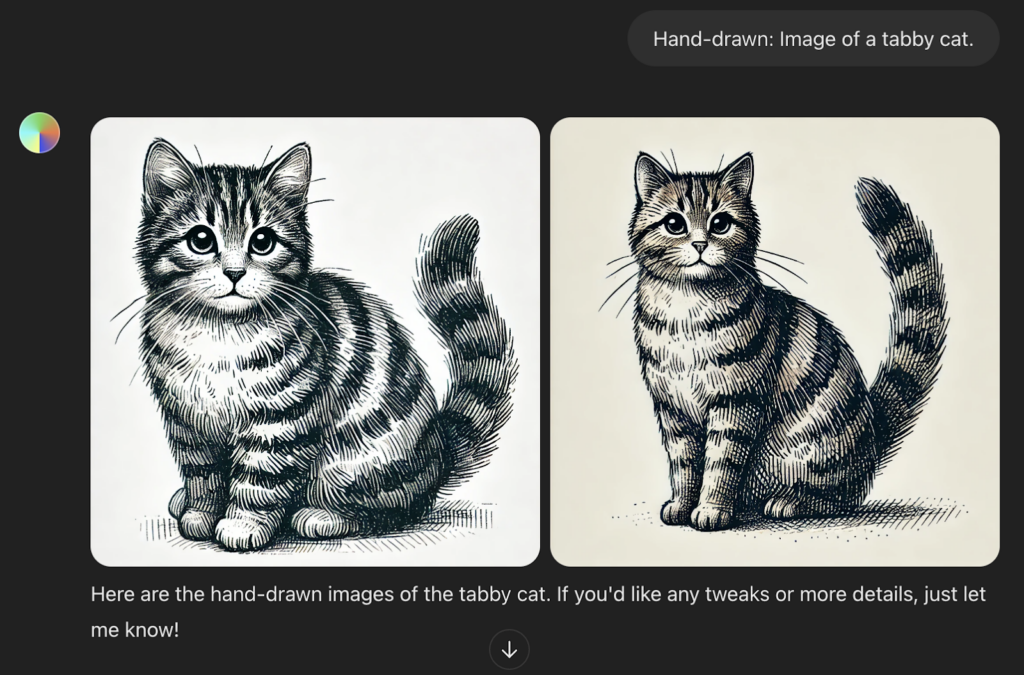
Quick Win 13: Optimizing anchor text
We can’t get this far into an article about SEO quick wins without mentioning anchor text optimization, can we?
Anchor text is the clickable text in a hyperlink, and when used effectively, it provides clear and relevant information about the linked content. This helps users navigate your site more efficiently, leading to better engagement metrics like a higher engagement rate and a longer dwell time.
While they’re the most important part, it’s not just users who benefit from optimized anchor text.
Anchor text signals to search engines what the linked page’s content is about. When anchor text includes relevant keywords, it can enhance the contextual relevance of the link and potentially boost the ranking of both the linked and linking pages. Optimized anchor text helps search engines understand the relationship between different pages on your site, improving overall crawlability and indexability.
An action item for optimizing anchor text across your site
You can use Screaming Frog to find the anchor text used across your site quickly. More specifically, you can use it to find instances of:
- Under-optimized anchor text
- Over-optimized anchor text
- Missing anchor text
Pick the page you wish to look at and choose the ‘inlinks’ tab at the bottom:
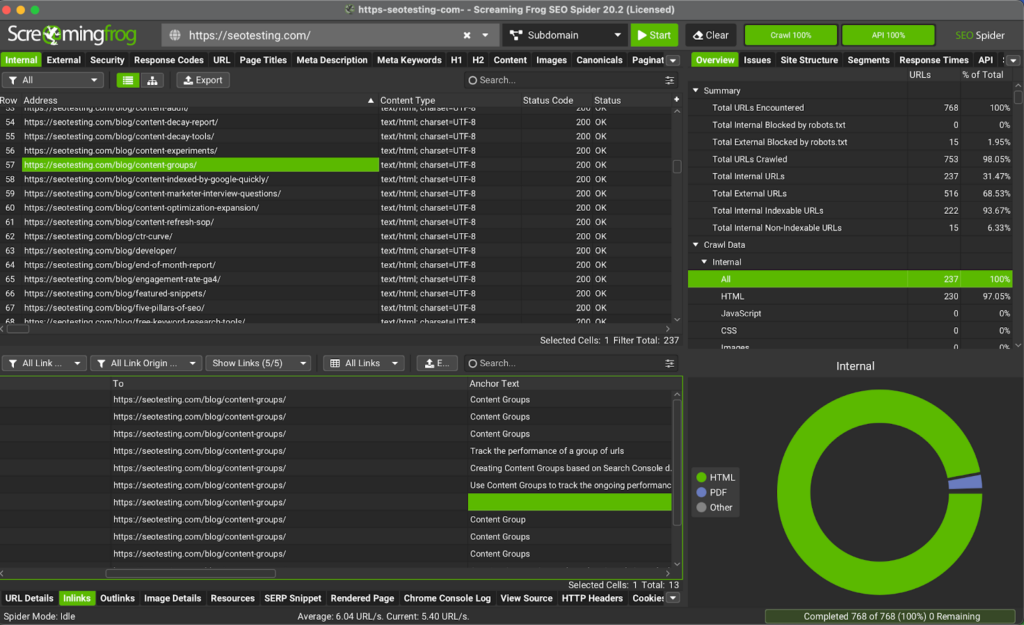
You can then find all the anchor text of links pointing to that page, so you can note any instances that need to be changed.
Quick Win 14: Leveraging featured snippets
In our opinion, one of the best SEO quick wins on this list is leveraging featured snippets as an attempt to improve site traffic. Take a look at this featured snippet that SEOTesting has on the SERP as an example:
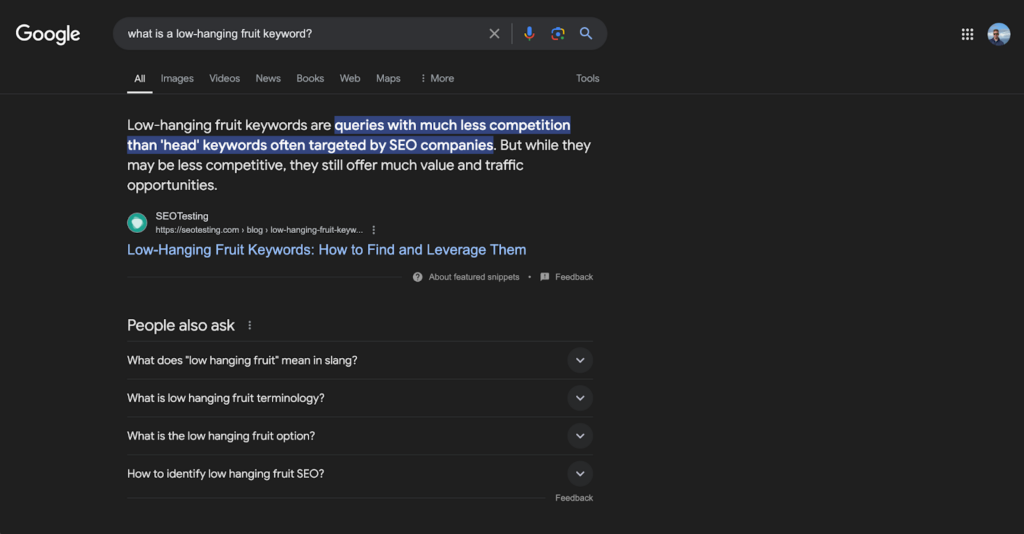
Look at how much SERP ‘real estate’ the featured snippet takes up. With the combination of the featured snippet and the People Also Ask box, you can’t see another SERP competitor above the fold.
To optimize for featured snippets, you need to structure your content to answer common questions directly. This can be done using clear headings, bullet points, numbered lists, and concise paragraphs addressing specific queries. Providing high-quality, relevant answers improves your chances of being selected for a featured snippet.
Featured snippets also establish your site as an authority on the topic, building user trust and encouraging further engagement. Increased visibility and credibility can drive organic traffic to your site and improve overall SEO performance. Since optimizing for featured snippets often involves making straightforward adjustments to existing content, it represents a highly effective and efficient SEO strategy.
An action item for leveraging featured snippets
You can use a tool like Ahrefs to identify all of your ranking keywords that include a featured snippet:
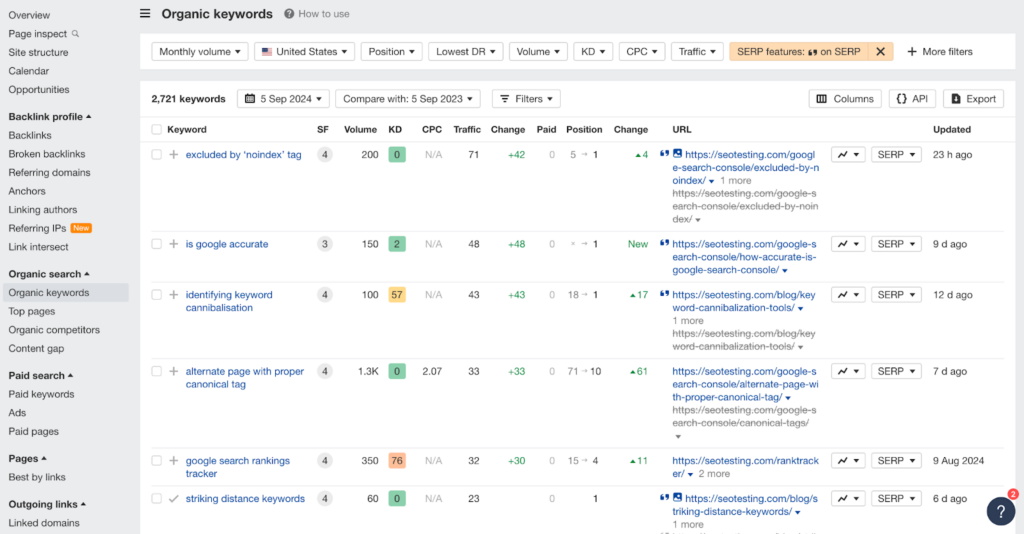
More specifically, you can run through this report to find instances where your website ranks in the top ten but does not have the featured snippet. Like this example:

You can then change this page to actively target the featured snippet.
Quick Win 15: Adding customer testimonials and reviews
Another simple and effective SEO quick win is adding customer testimonials and reviews to your website. Here’s an example of how we’ve done this at SEOTesting:
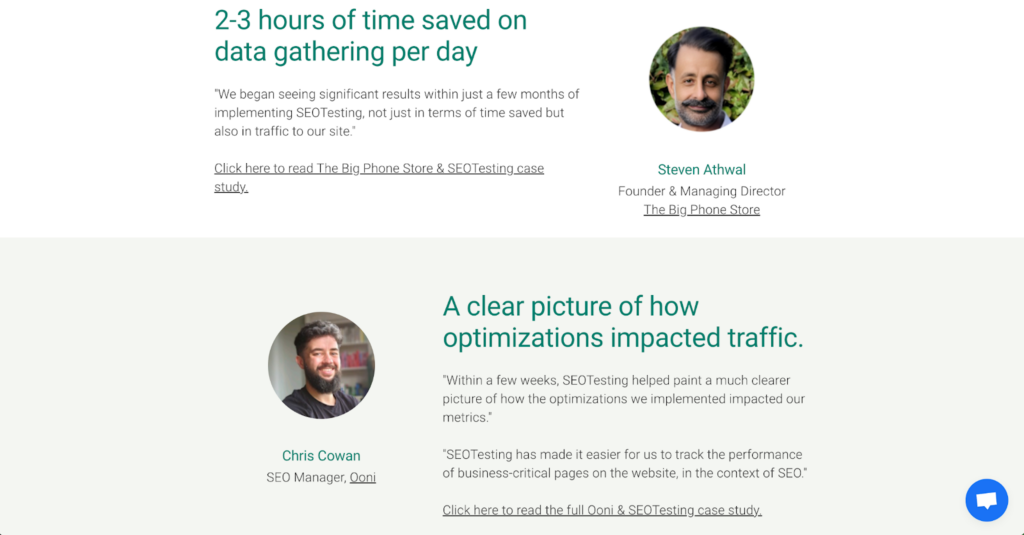
Testimonials and reviews provide an unbiased, third-party perspective, showing potential customers that others have had positive experiences with your products or services. This builds trust and can significantly influence purchasing decisions, leading to higher conversion rates.
Adding this content to your website benefits SEO performance, too. Customer reviews and testimonials often naturally contain relevant keywords (without the author realizing it!), which can help improve your site’s visibility in search engine results. These user-generated content pieces are regularly updated and provide fresh content, which search engines favor. Additionally, reviews can increase visitors’ time on your site as they read through feedback, leading to lower bounce rates.
An action item for using reviews on your website
Create a dedicated section on the website for customer testimonials and reviews. Ensure these reviews are displayed prominently across relevant product and service pages. Regularly update this section with fresh customer feedback to boost trust, naturally integrate keywords, and improve SEO performance. This will help improve search engine visibility and reduce bounce rates by encouraging extended site visits.
Quick Win 16: Creating FAQ sections in articles
If you’ve read a handful of our articles, you may have noticed that we consistently include FAQ sections where relevant.
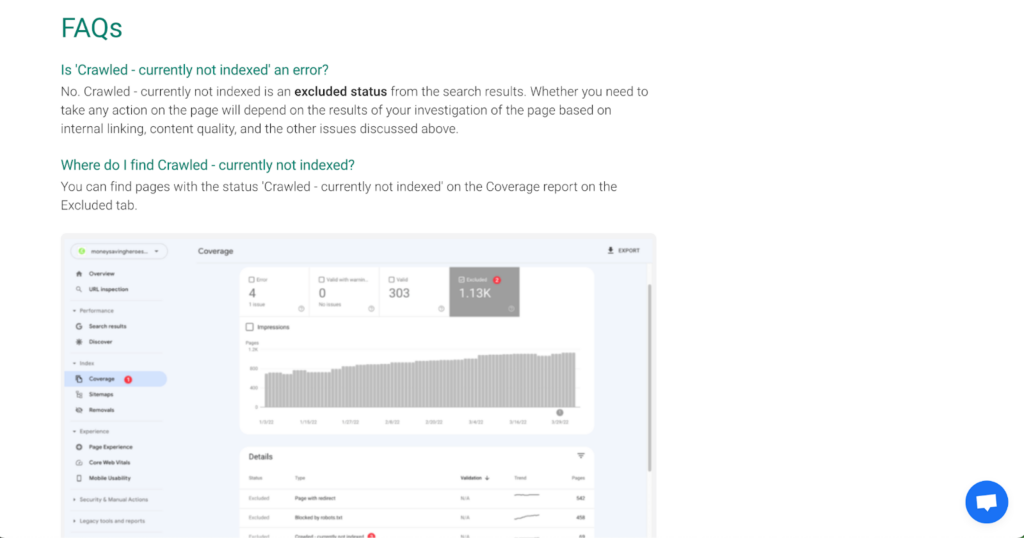
Featuring an FAQ section in your blog posts, both in articles you’re writing and existing content, is a great way of enhancing users’ experience on your site. Talk about an SEO win.
FAQ sections address common questions directly, providing immediate value to users seeking specific information, and may encourage them to stay on your site longer and explore more of your content.
They often include long-tail keywords and natural language queries that users frequently type into search engines. By answering these questions within your articles, you increase the likelihood of your content appearing in search results of these queries, potentially earning featured snippets or placements within Google’s People Also Ask boxes.
An action item for utilizing FAQs on your website
You can use the Questions to Answer report from SEOTesting to identify questions that your site already ranks for:
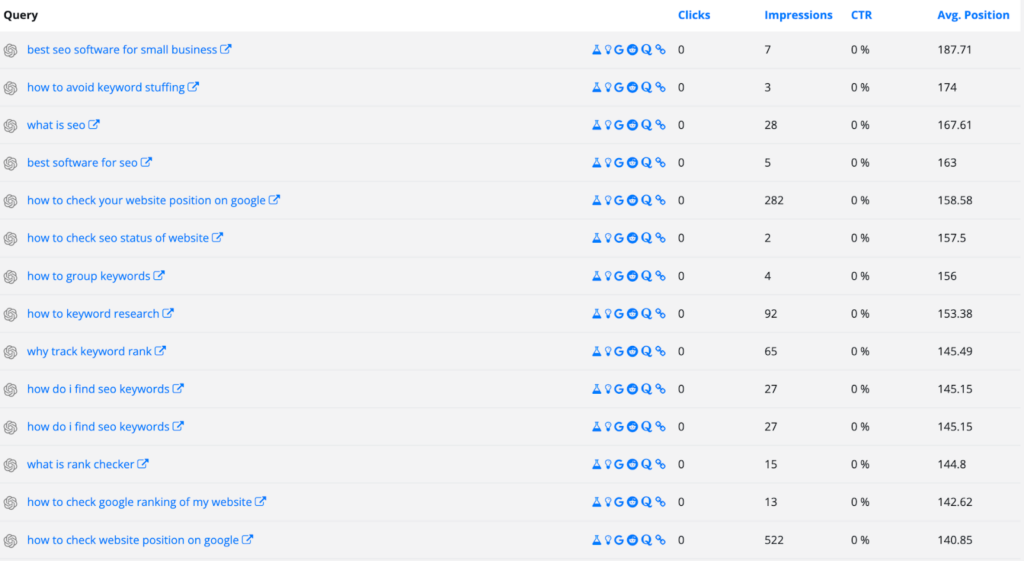
You can then answer these questions directly within the already-ranking piece of content or by creating a new piece of content to target that question specifically. For example, the screenshot above shows an average position of 158.58 for the question “how to check your website position on Google.” When we look at the ranking page for that query, we can see it is our page on Google Search Console’s average position metric:
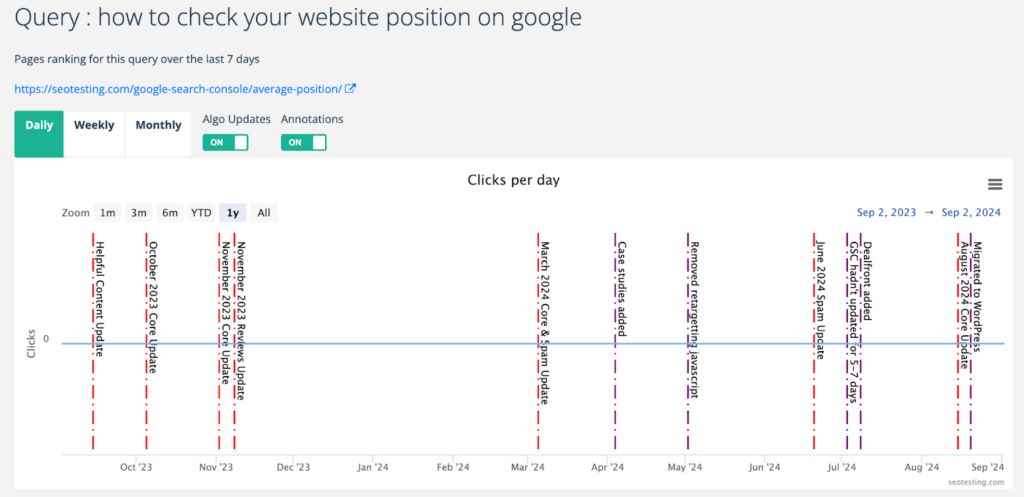
To generate clicks for this query, we could create new content titled “How to check your website position on Google.”

Quick Win 17: Improving website architecture
One of the best ways to enhance your user experience, facilitate better navigation, and potentially boost search engine rankings is to improve your website architecture.
A well-structured website makes it easier for visitors to find the information they need, leading to increased engagement, lower bounce rates, and higher conversion rates. Clear, logical navigation helps users move through your site easily, improving their experience and, hopefully, time on your site too.
A well-organized website architecture ensures that search engine crawlers can efficiently index your pages. This includes having a clear hierarchy with appropriately categorized content, using descriptive and optimized URLs, and implementing a clear internal linking strategy. When search engines can easily understand and navigate your site, it can lead to better indexing and even higher rankings in the search results.
We touched on internal linking earlier. A good website architecture helps distribute link equity throughout your site, ensuring that essential pages receive the necessary authority and visibility.
Simple changes such as organizing content into relevant categories, creating a sitemap, and ensuring your website has a clean URL structure can have an immediate and significant effect on its SEO performance.
An action item for quickly improving site architecture
Google Search Console is the best place to quickly get insights into issues with your site architecture, as issues with your site architecture can cause issues with page indexing. It’s important to check your page indexing report and specifically look at the reasons pages are not being indexed to identify potential issues with site infrastructure:
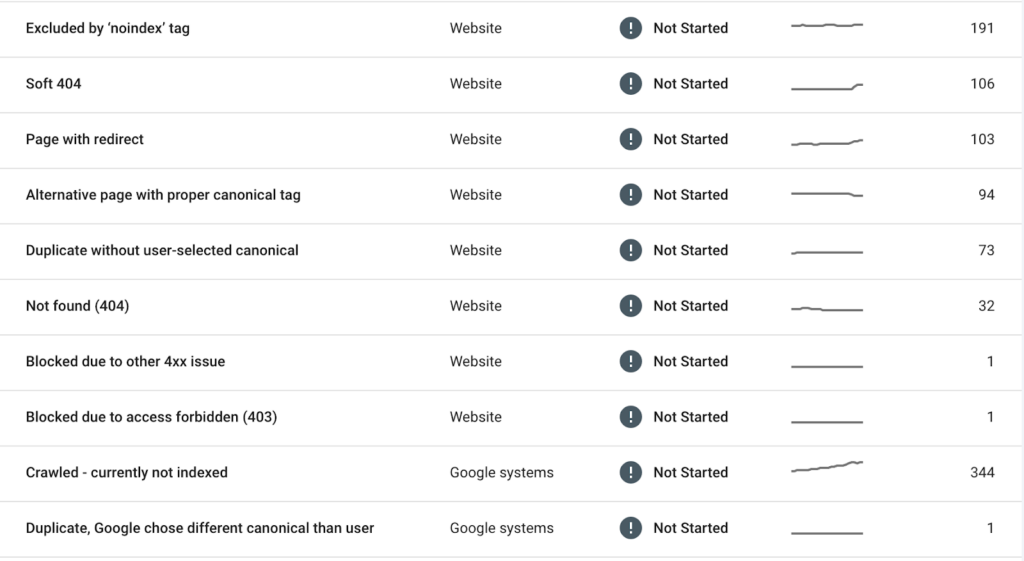
Keep an eye on the trend lines, specifically. Any trend lines that start rapidly growing could indicate a recent change on your site that has caused site architecture issues.
Quick Win 18: Utilizing breadcrumb navigation
Using breadcrumb navigation effectively enhances user experience, improves site navigation, and helps search engines index your site. Breadcrumbs provide a clear and straightforward path for users to trace their steps back to previous pages or the homepage, making complex websites easier to navigate.
We have to include a special mention here for ecommerce sites.
For ecommerce sites, breadcrumbs navigation is crucial as it helps users understand the site’s structure and find products more efficiently. This enhanced navigation reduces the likelihood of users becoming frustrated and leaving the site, leading to higher engagement and conversion rates. Breadcrumbs also encourage users to explore other site sections and relevant products.
From a general SEO perspective, breadcrumb navigation helps search engines understand your site’s hierarchy and structure. This can lead to better indexing and higher rankings in search results. Breadcrumbs also create additional internal links, which can help distribute link equity throughout the site and improve the authority of key pages.
Here is a practical example of breadcrumb navigation:
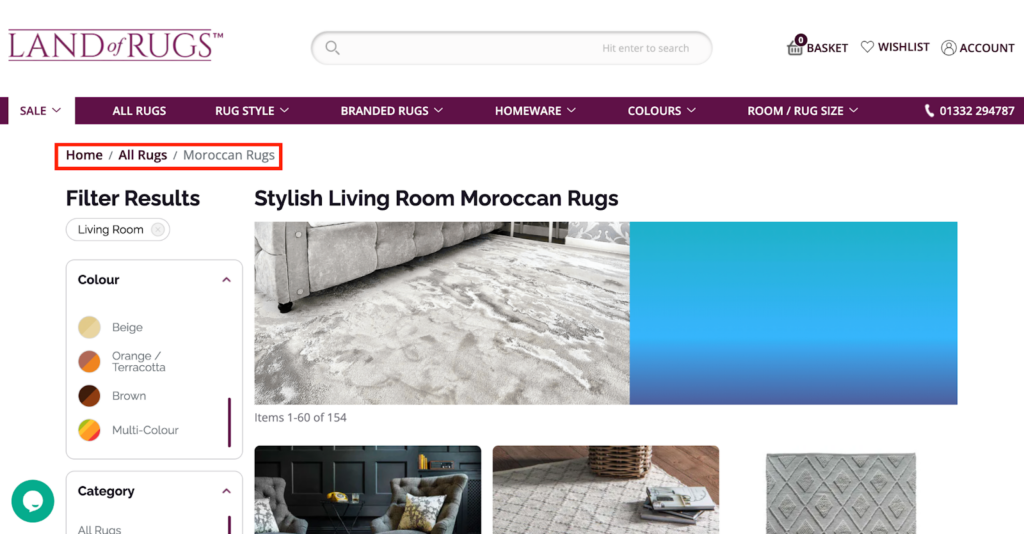
This is taken from the Land of Rugs website. It is simple and takes up little screen real estate—a great example.
An action item for implementing breadcrumb navigation
Use BreadcrumbList schema (structured data) to help search engines better understand your site hierarchy, which can enhance SEO and improve your appearance in search results. Google may display breadcrumbs in search snippets.
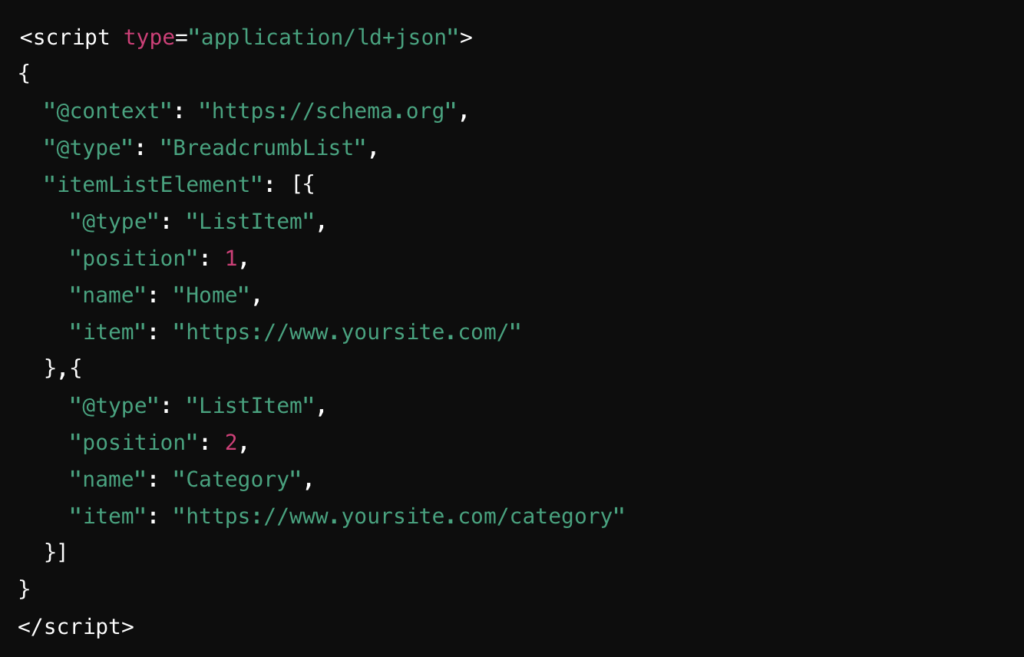
Quick Win 19: Checking for crawl errors
Perhaps one of the quickest SEO wins you can implement is checking for crawl errors via Google Search Console.
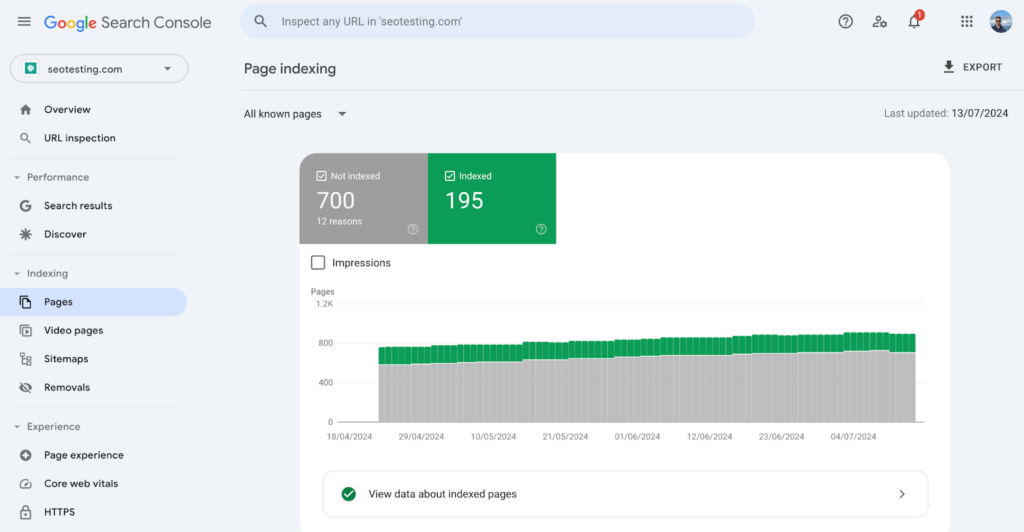
This allows you to identify and fix issues that prevent search engines from effectively indexing your site. Crawl errors, such as broken links or server errors, can hinder search engines from accessing and understanding your content, negatively impacting your site’s visibility and rankings.
Monitoring and addressing these errors ensures that search engines can efficiently crawl and index your site. This can improve your chances of appearing in search results and drive more organic traffic with minimal effort.
For more information, review our guide to Google Search Console indexing errors.
An action item for reviewing crawl errors
Reviewing crawl errors in Google Search Console at regularly scheduled intervals is a great way to stay on top of new crawl errors and check the status of fixes you have implemented from previous audits. Set aside time in your calendar each week or month to review your crawl reports in Google Search Console.
Quick Win 20: Optimizing 404 pages
As your website grows, more of your site’s users will inevitably come across a 404 page on your website. But a quick win here is optimizing your site’s 404 page to help filter traffic through to other pages rather than bounce and head back to the search engine.
Here is a 404-page example from CopyHackers that encourages users to return to the homepage rather than the SERP.
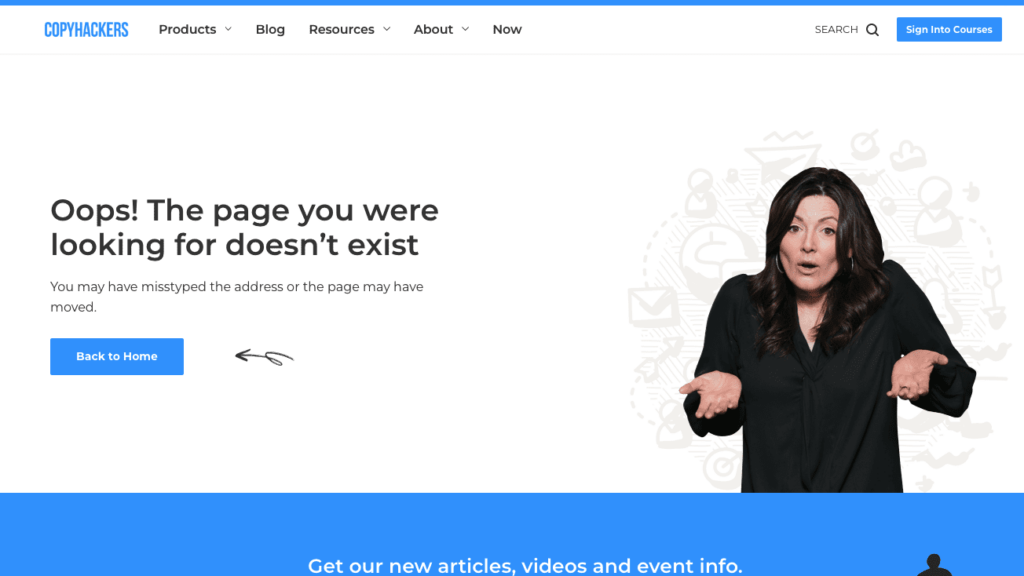
Additionally, a custom 404 page can improve your brand image by reflecting your site’s style and tone, turning a potentially negative experience into a positive one. By implementing a user-friendly 404 page, you can minimize the negative impact of broken links and improve overall site performance and user satisfaction.
An action item for better-optimized 404 pages
If you do not already have one, implement a site search bar on your 404 pages and try to divert the user’s attention to it. This may guide them to search for an alternative page on your site rather than just bouncing and heading back to the search engine. Great for on-page metrics!
How to test page changes
You can use SEOTesting to test the impact of any change you make to your website. Let’s walk you through an example to show just how easy it is to create an SEO test with our tool and start tracking the impact of your change.
Let’s take this article as an example:
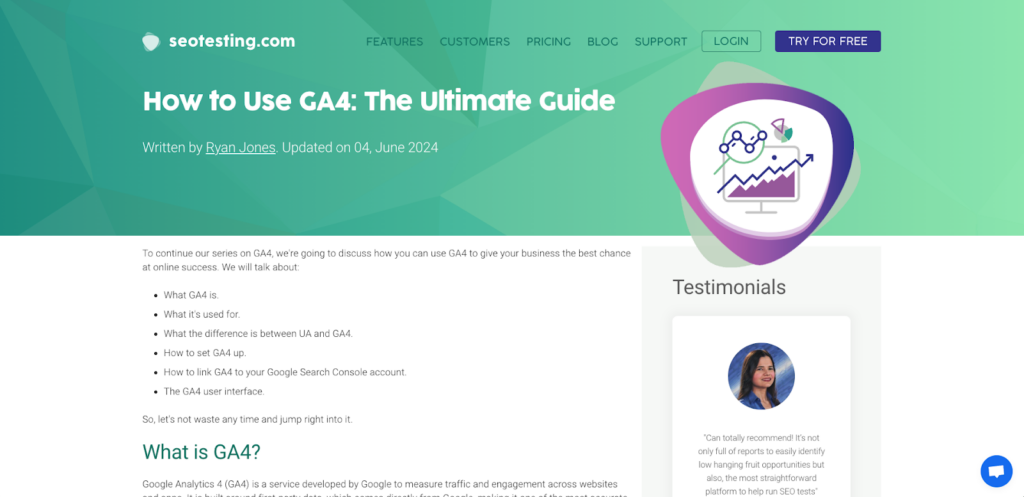
First, we would follow our content refresh process by re-writing the content and publishing the amended page.
Our next step would be to head to our SEOTesting dashboard and click on “SEO tests” via the navigation bar on the left-hand-side of the dashboard:
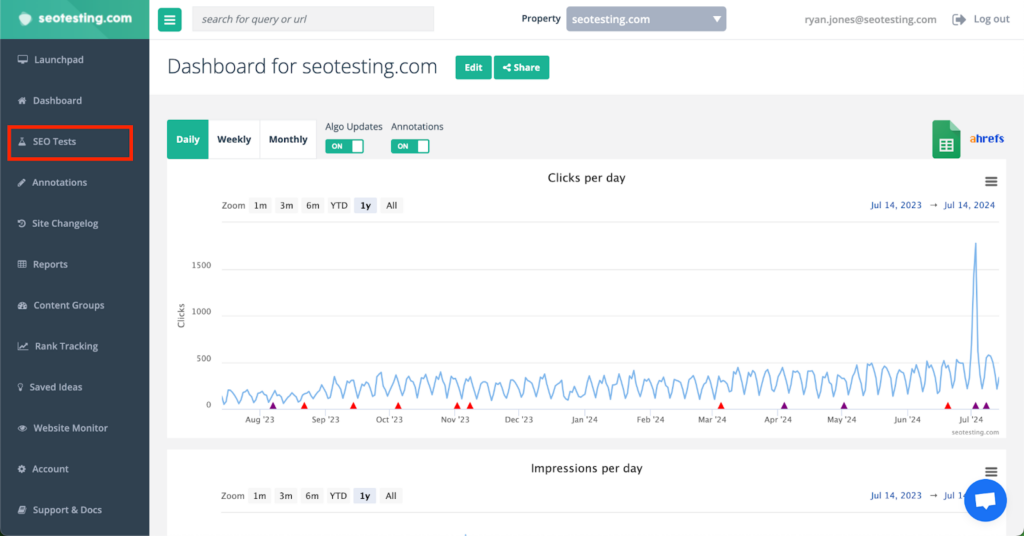
We would then click on the button to create a new SEO test:
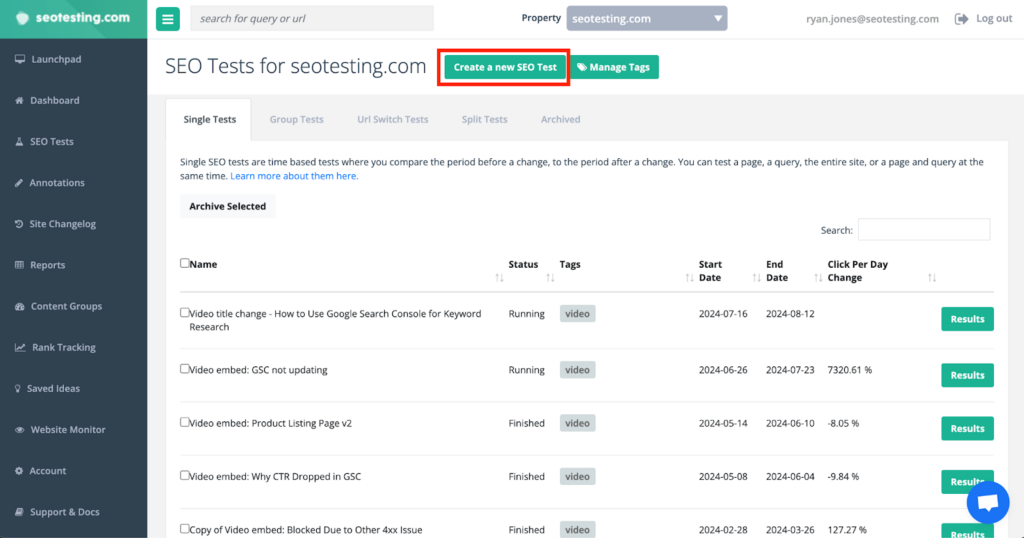
As this is a content refresh only impacting a single page, we would want to create a single-page test:
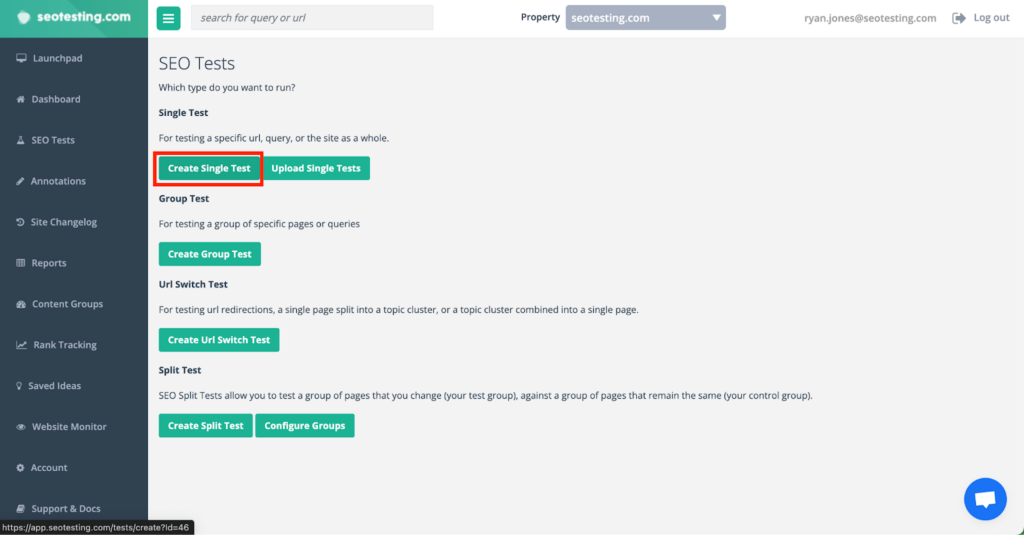
Now we are in the test wizard, we’ll fill in the details and click ‘Create’ at the bottom of the screen:
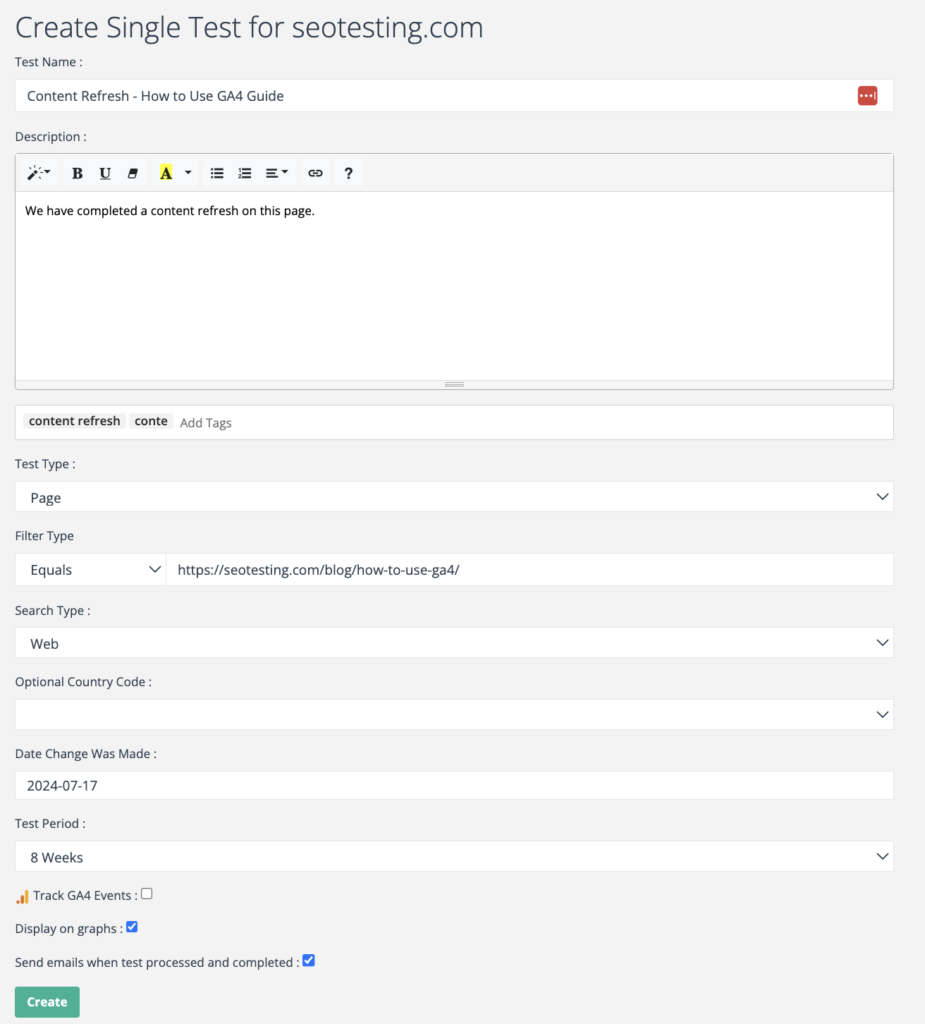
A second screen will pop up, asking us to confirm the test dates. Once we have completed this, the test will start creating and tracking data for that page over the duration you asked it to run.
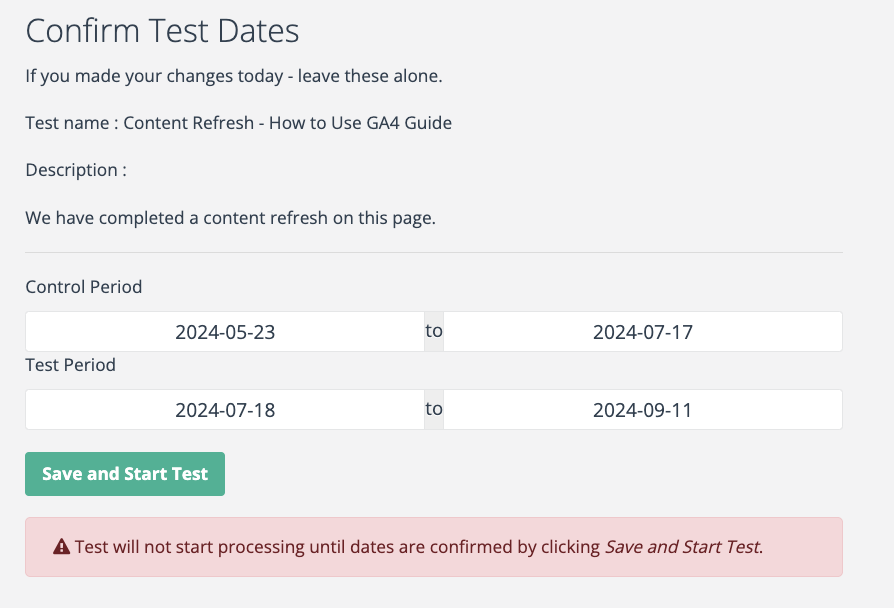
Now, we can start our test and let it run. Over time, SEOTesting will track:
- Clicks
- Impressions
- Click-Through Rate
- Average Position
- Number of Queries
At the end of the test, we can confirm whether the content refresh worked.
Wrapping up
Implementing these SEO quick wins can significantly improve your website’s organic traffic and visibility with minimal effort. Focusing on strategies such as optimizing meta tags, improving page load speed, fixing broken links, and enhancing mobile usability can help you achieve the results you’re looking for.
These foundational steps provide quick gains and prepare your site for more complex, long-term SEO initiatives. Regularly updating content, leveraging user-generated content, and using tools like SEOTesting to track changes ensure your efforts are effective and continuously improving.
Start with these quick wins to boost your SEO performance and lay the groundwork for sustained success. By addressing these areas, you can create a robust SEO strategy that delivers both short-term results and long-term growth.
If you want to test SEOTesting and see how this list of quick wins impacts your site traffic, sign up for our 14-day free trial today. No credit card information is required.


